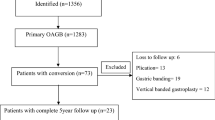Abstract
Background
The study aim is to determine if patients who have undergone endoscopic gastrojejunostomy revision (EGJR) maintain weight loss up to 5 years postoperatively.
Methods
This is a retrospective review of patients who underwent EGJR with a full-thickness endoscopic suturing device between April 2009 and June 2018. Percent of excess body weight loss (%EBWL) was calculated using the weight on day of EGJR consult as baseline. The paired t test and McNemar’s test were used to compare weight and comorbidities between preoperative and postoperative time points.
Results
A total of 70 patients regained a mean of 42.8 ± 18.7% of the weight lost after gastric bypass. On day of EGJR consult, average was 116.1 ± 25.2 kg and BMI of 42.3 ± 8.5. Weight loss and %EBWL at follow-up was as follows: 10.7 ± 11.6 kg and 18.5 ± 18.2% at 6 months, 8.5 ± 11.5 kg and 14.9 ± 20.6% at 1 year, 6.9 ± 10.7 kg and 12.2 ± 19.8% at 2 years, 5.3 ± 9.1 kg and 8.7 ± 14.9% at 3 years, 3.1 ± 12.0 kg and 3.2 ± 21.6% at 4 years, and 3.9 ± 13.1 kg and 7.0 ± 23.8% at 5 years. The percentage of patients with obstructive sleep apnea, hypertension, hyperlipidemia, and diabetes did not change over time. Patients who received a pursestring revision or had a greater percent reduction in stoma diameter had more significant %EBWL.
Conclusions
Weight loss after EGJR is sustained up to 5 years after revision with little effect on medical comorbidities. Patients with a greater reduction in stoma diameter experienced superior weight loss.




Similar content being viewed by others
References
Odom J, Zalesin KC, Washington TL, Miller WW, Hakmeh B, Zaremba DL, Altattan M, Balasubramaniam M, Gibbs DS, Krause KR, Chengelis DL, Franklin BA, McCullough PA (2010) Behavioral predictors of weight regain after bariatric surgery. Obes Surg 20:349–356. https://doi.org/10.1007/s11695-009-9895-6
Sjöström L, Lindroos A-K, Peltonen M, Torgerson J, Bouchard C, Carlsson B, Dahlgren S, Larsson B, Narbro K, Sjöström CD, Sullivan M, Wedel H, Swedish Obese Subjects Study Scientific Group (2004) Lifestyle, diabetes, and cardiovascular risk factors 10 years after bariatric surgery. N Engl J Med 351:2683–2693. https://doi.org/10.1056/nejmoa035622
Christou NV, Sampalis JS, Liberman M, Look D, Auger S, McLean APH, MacLean LD (2004) Surgery decreases long-term mortality, morbidity, and health care use in morbidly obese patients. Ann Surg 240:416–423 (discussion 423)
Shah M, Simha V, Garg A (2006) Review: long-term impact of bariatric surgery on body weight, comorbidities, and nutritional status. J Clin Endocrinol Metab 91:4223–4231. https://doi.org/10.1210/jc.2006-0557
Hallowell PT, Stellato TA, Yao DA, Robinson A, Schuster MM, Graf KN (2009) Should bariatric revisional surgery be avoided secondary to increased morbidity and mortality? Am J Surg 197:391–396. https://doi.org/10.1016/j.amjsurg.2008.11.011
Kellogg TA (2011) Revisional bariatric surgery. Surg Clin North Am 91(1353–71):x. https://doi.org/10.1016/j.suc.2011.08.004
Shimizu H, Annaberdyev S, Motamarry I, Kroh M, Schauer PR, Brethauer SA (2013) Revisional bariatric surgery for unsuccessful weight loss and complications. Obes Surg 23:1766–1773. https://doi.org/10.1007/s11695-013-1012-1
Herron DM, Birkett DH, Thompson CC, Bessler M, Swanström LL (2008) Gastric bypass pouch and stoma reduction using a transoral endoscopic anchor placement system: a feasibility study. Surg Endosc 22:1093–1099. https://doi.org/10.1007/s00464-007-9623-z
Vargas EJ, Bazerbachi F, Rizk M, Rustagi T, Acosta A, Wilson EB, Wilson T, Neto MG, Zundel N, Mundi MS, Collazo-Clavell ML, Meera S, Abu-Lebdeh HS, Lorentz PA, Grothe KB, Clark MM, Kellogg TA, McKenzie TJ, Kendrick ML, Topazian MD, Gostout CJ, Abu Dayyeh BK (2018) Transoral outlet reduction with full thickness endoscopic suturing for weight regain after gastric bypass: a large multicenter international experience and meta-analysis. Surg Endosc 32:252–259. https://doi.org/10.1007/s00464-017-5671-1
Kumar N, Thompson CC (2016) Transoral outlet reduction for weight regain after gastric bypass: long-term follow-up. Gastrointest Endosc 83:776–779. https://doi.org/10.1016/j.gie.2015.08.039
Patel LY, Lapin B, Brown CS, Stringer T, Gitelis ME, Linn JG, Denham WE, Farwell E, Haggerty S, Ujiki MB (2017) Outcomes following 50 consecutive endoscopic gastrojejunal revisions for weight gain following Roux-en-Y gastric bypass: a comparison of endoscopic suturing techniques for stoma reduction. Surg Endosc 31:2667–2677. https://doi.org/10.1007/s00464-016-5281-3
Hedberg HM, Trenk A, Kuchta K, Linn JG, Carbray J, Ujiki MB (2018) Endoscopic gastrojejunostomy revision is more effective than medical management alone to address weight regain after RYGB. Surg Endosc 32:1564–1571. https://doi.org/10.1007/s00464-018-6073-8
Hedberg HM, Trenk A, Ujiki MB (2018) Modeling suture patterns for endoscopic gastrojejunostomy revision: analyzing a technique to address weight regain after gastric bypass. Surg Obes Relat Dis 14:569–575. https://doi.org/10.1016/j.soard.2018.01.030
Schulman AR, Kumar N, Thompson CC (2018) Transoral outlet reduction: a comparison of purse-string with interrupted stitch technique. Gastrointest Endosc 87:1222–1228. https://doi.org/10.1016/j.gie.2017.10.034
Kumar N (2016) Weight loss endoscopy: development, applications, and current status. World J Gastroenterol 22:7069–7079. https://doi.org/10.3748/wjg.v22.i31.7069
Author information
Authors and Affiliations
Corresponding author
Ethics declarations
Disclosures
Dr. Ujiki is a consultant for Olympus, on the Boston Scientific scientific advisory board, a consultant and speaker for Apollo Medical Devices, a speaker for Medtronic, and a speaker for Gore Medical.Dr. Callahan, Dr. Su, Ms. Kuchta, Dr. Linn, and Ms. Carbray have no conflicts of interest or financial ties to disclose.
Additional information
Publisher's Note
Springer Nature remains neutral with regard to jurisdictional claims in published maps and institutional affiliations.
Rights and permissions
About this article
Cite this article
Callahan, Z.M., Su, B., Kuchta, K. et al. Five-year results of endoscopic gastrojejunostomy revision (transoral outlet reduction) for weight gain after gastric bypass. Surg Endosc 34, 2164–2171 (2020). https://doi.org/10.1007/s00464-019-07003-6
Received:
Accepted:
Published:
Issue Date:
DOI: https://doi.org/10.1007/s00464-019-07003-6




